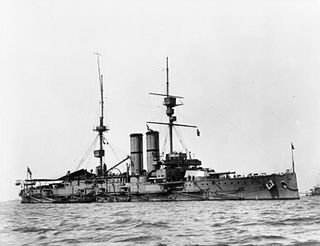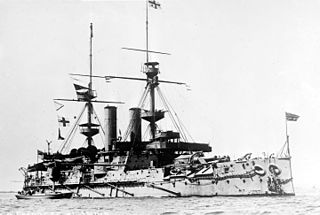This is a list of Royal Navy ship names starting with C.
This is a list of Royal Navy ship names starting with C.

The Castle-class corvette was an ocean going convoy escort developed by the United Kingdom during the Second World War. It was the follow-on to the Flower-class corvette, and designed to be built in shipyards that were producing the Flowers. The Castle-class was a general improvement over the smaller Flowers which were designed for coastal rather than open ocean use.

HMS Hibernia was a King Edward VII-class pre-dreadnought battleship of Britain's Royal Navy. Like all ships of the class she was named after an important part of the British Empire, namely Ireland. The ship was built by Devonport Dockyard; she was laid down in January 1904, was launched in June 1905, and was completed in December 1906. Armed with a battery of four 12-inch (305 mm) and four 9.2 in (234 mm) guns, she and her sister ships marked a significant advance in offensive power compared to earlier British battleship designs that did not carry the 9.2 in guns.
Parsons Marine Steam Turbine Company was a British engineering company based on the River Tyne at Wallsend, North East England.

SS Cap Trafalgar was a German ocean liner launched in 1913 for the Hamburg Süd line. In 1914, she was converted for use as an auxiliary cruiser during World War I. She was the first armed merchant cruiser sunk by a ship of the same class; she was destroyed by HMS Carmania, also a converted ocean liner, in a furious action in the South Atlantic on 14 September 1914. It was the world's first battle between former ocean liners.
Admiral Sir William Edmund Goodenough was a senior Royal Navy officer of World War I. He was the son of James Graham Goodenough.

HMS Empress of India was one of seven Royal Sovereign-class pre-dreadnought battleships built for the Royal Navy during the 1890s. The ship was commissioned in 1893 and served as the flagship of the second-in-command of the Channel Fleet for two years. She was transferred to the Mediterranean Fleet in 1897, during which time Empress of India was assigned to the International Squadron blockading Crete during the uprising there. She returned home in 1901 and was briefly assigned as a coast guard ship in Ireland before she became the second flagship of the Home Fleet. The ship was reduced to reserve in 1905 and accidentally collided with the submarine HMS A10 the following year. Empress of India was taken out of service in early 1912 and accidentally struck a German sailing ship while under tow. She was sunk as a target ship in 1913.
HMS Chepstow was a Racecourse-class minesweeper of the Royal Navy built in 1916. The Racecourse Class comprised 32 paddlewheel coastal minesweeping sloops. The vessel was named for Chepstow Racecourse.

Bonaventure was a 47-gun galleon purchased by the Royal Navy in 1567. She was the third vessel to bear the name. She was commanded by Sir Francis Drake during his 1587 attack on Cadiz, and a year later was part of the fleet to face the Spanish Armada.
Admiral Wilmot Stuart Nicholson CB was a Royal Navy officer who became Chief of the Submarine Service.

HMS Onslaught was a Admiralty M-class destroyer which served with the Royal Navy during the First World War. The M class were an improvement on the previous L-class, capable of higher speed. The vessel, launched in 1915, joined the Twelfth Destroyer Flotilla under the flotilla leader Faulknor. The ship saw action during the Battle of Jutland in May 1916, jointly sinking the German torpedo boat SMS V48 and launching the torpedo that sank the pre-dreadnought battleship Pommern, the only German battleship to be lost in the battle. Subsequently, the destroyer acted as an escort to other naval ships during the Action of 19 August 1916 and took part in anti-submarine operations. At the end of the war, Onslaught was withdrawn from service and, in 1921, sold to be broken up.